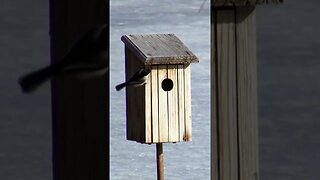Premium Only Content

Butterfly Bush: Perennial Flowers for the Full Sun (Best Plant for a Pollinator Garden)
The butterfly bush, a stunning and fragrant perennial shrub, is cherished by gardeners for its ability to attract butterflies and other pollinators. This article will delve into the essentials of butterfly bush cultivation, its uses in the garden, and the beautiful characteristics that make it a popular choice for landscaping.
The butterfly bush, known scientifically as Buddleja (or Buddleia), belongs to the Scrophulariaceae family. There are over 100 species within the Buddleja genus, with Buddleja davidii being the most common species cultivated in gardens. This species is native to central China and Tibet and has been widely introduced to gardens around the world for its ornamental value and wildlife appeal.
Ideal Growing Conditions.
Soil: Butterfly bush prefers well-draining, loamy soil with a pH level between 6.0 and 7.0. It can tolerate many soil types, but good drainage is essential to prevent root rot.
Light: Butterfly bush requires full sun, meaning at least 6 to 8 hours of direct sunlight daily. This helps the plant produce its vibrant flowers and attract pollinators.
USDA Planting Zones: Butterfly bush best suits USDA zones 5 to 9. It can withstand some frost, but it may die back to the ground in colder climates and regrow in the spring.
Planting Butterfly Bush.
When to plant: The best time to plant butterfly bush is in the spring, after the risk of frost has passed. This allows the plant ample time to establish itself before the winter months.
Choosing a location: Select a site with full sun exposure and well-draining soil. Consider the plant's mature size when choosing a location, as some varieties can reach up to 12 feet in height and width.
Preparing the soil: Amend the soil with organic matter or compost if necessary, to improve drainage and provide nutrients.
Planting: Dig a hole twice as wide as the root ball of the butterfly bush plant. Place the plant in the hole, ensuring the top of the root ball is level with the soil surface. Fill in the hole with soil and gently firm it around the plant.
Watering: Water the newly planted butterfly bush deeply, ensuring the soil is thoroughly moistened.
Butterfly Bush Maintenance.
Pruning: Prune butterfly bush in the late winter or early spring, cutting back the previous year's growth to about 12 inches above the ground. This will encourage vigorous new growth and abundant flowering.
Watering: Water the butterfly bush regularly, allowing the soil to dry out slightly between waterings. Overwatering can lead to root rot and other diseases.
Fertilizing: Apply a balanced, slow-release fertilizer in the spring to support healthy growth and flowering.
Attract beautiful wildlife.
Butterfly bushes are a popular choice for wildlife gardens, as their nectar-rich flowers attract pollinators, including butterflies, bees, and hummingbirds. When planted in groups, they can also be used as a focal point in mixed borders, foundation plantings, or as a privacy screen.
The Beauty of Butterfly Bush: Fragrance and Appearance.
Butterfly bushes are known for their captivating, cone-shaped flower panicles that bloom in shades of purple, pink, white, yellow, or red. Their sweet, honey-like fragrance is delightful and can be enjoyed from afar. The shrub's arching branches are adorned with elongated, lance-shaped leaves that provide a lush backdrop for the vibrant flowers.
Propagating the butterfly bush.
Butterfly bush reproduces through seeds and vegetative propagation. When propagating by seed, start them indoors 8 to 10 weeks before the last frost date. Transplant the seedlings outdoors once they have grown at least 3 to 4 inches tall and the risk of frost has passed.
Softwood or semi-hardwood cuttings can be taken from mature plants during late spring or early summer for vegetative propagation. These cuttings should be planted in a well-draining soil mix and kept in a sheltered, warm location until they develop roots. Once rooted, they can be transplanted to their permanent location in the garden.
Give the butterfly bush a chance.
The butterfly bush is a versatile, fragrant, and visually appealing shrub that can enhance any garden with its vibrant blooms and ability to attract pollinators. By understanding its cultivation requirements and recognizing its uses in the garden, you can enjoy the many benefits that the butterfly bush has to offer. Add this alluring plant to your garden, and experience the enchanting world of butterfly bush firsthand.
Connect with us
Facebook: https://www.facebook.com/TayloesLawnCare
Web: https://www.tayloeslawncare.com
MeWe: https://mewe.com/p/diyhomegarden
Image and music licensed via Canva Pro
-
 0:33
0:33
Garden Revelations
1 year agoCarolina Chickadees: An adorable, year-round native bird species in the southeastern United States
1951 -
 UPCOMING
UPCOMING
I_Came_With_Fire_Podcast
7 hours agoThe Kelly-Hopkinsville Goblins Encounter, Synchronicity, & Interdimensionality
499 -
 LIVE
LIVE
Grant Cardone
2 hours agoReal Estate Interactive
6,535 watching -
 1:10:41
1:10:41
Wendy Bell Radio
5 hours agoPet Talk With The Pet Doc
71.3K7 -
 LIVE
LIVE
FyrBorne
5 hours ago🔴Warzone M&K Sniping: Drop In For Battlefield 6 Info From The Event
3,719 watching -
 29:00
29:00
DeVory Darkins
15 hours ago $13.78 earnedTrump smacks Russia with CHILLING WARNING Cincinnati officials EXPLODE over viral fight
42.3K91 -
 1:12:40
1:12:40
Omar Elattar
17 hours ago71 Mins With A Hollywood Comedian & Dating Expert: #1 Reason Men Can't Find "The One" (4,000 Study)
3.26K1 -
 LIVE
LIVE
BBQPenguin_
5 hours agoTasking & PVP! ALL DAY!
44 watching -
 LIVE
LIVE
DoldrumDan
5 hours agoNEW PC TEST #2 NIGHTREIGN INTO FIRST TIME SEEING ELDEN RING IN HD
49 watching -
 18:02
18:02
James Klüg
2 days agoConfronting Unhinged Protesters At Musk's Tesla Diner + Food Review!
33.9K31